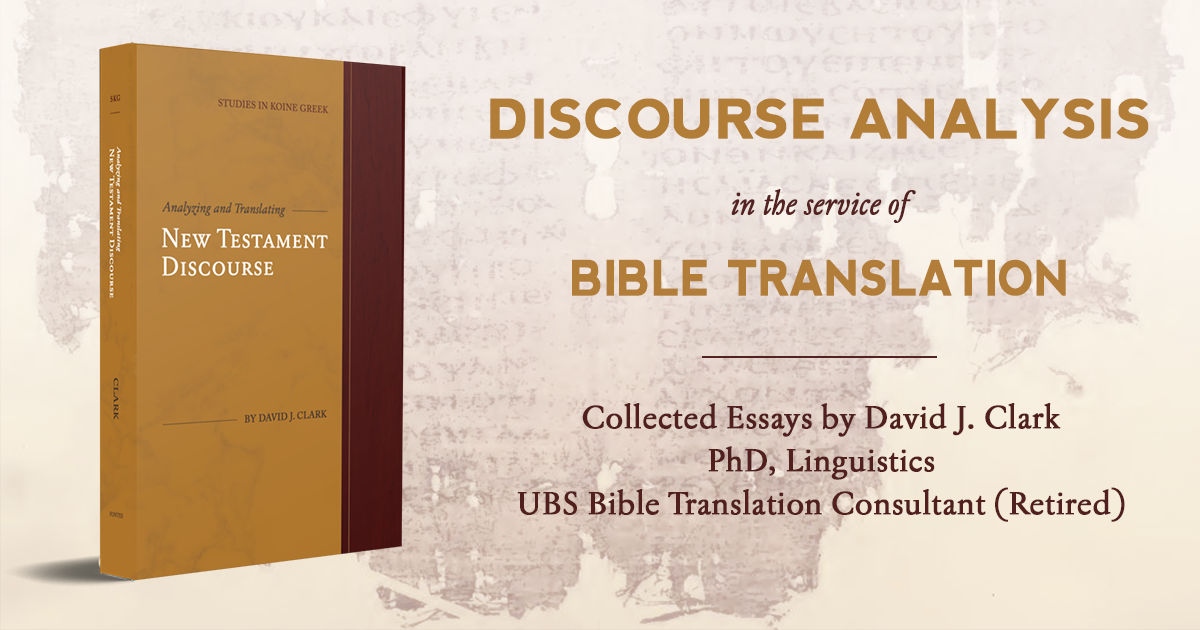New from Fontes Press is a collection of essays by linguist, Bible translation consultant, and classics scholar David J. Clark. When Clark earned his PhD in linguistics around 1970, discourse studies were just blossoming. Scholars (especially European) were creating “text grammars” and exploring levels of language above the sentence unit. Clark studied many of the seminal works that are still cited today (e.g., Halliday and Hasan’s Cohesion in English) and began to integrate discourse insights into his work analyzing the Bible and serving in Bible translation.
From the end of the 1970’s, Clark published a number of articles in The Bible Translator and other journals or books. Some of them analyzed phrases that are difficult to translate across languages, such as “Father in heaven” and “after three days.” How should Bible translators handle the word “heaven” since some languages have several different terms for the concept. How should translators handle translating “after three days” vs. “on the third day?” Combining exegesis, discourse considerations, and linguistic theory, Clark gives suggestions for translators that will also help any scholar think more carefully about exegesis.
In 1982, Clark published a 100 page discourse analysis of Matthew’s Gospel in Scriptura. To date, I have never seen it cited. In fact, I have not found one full discourse analysis of any of the Gospels. (And I spent a year researching sources and contributors to our forthcoming Discourse Analysis of the New Testament Writings, so if there is one out there, it’s very obscure.) Having been written in 1982, one might think it is dated. But I worked with Clark to update and condense the work for the aforementioned edited volume, and after researching structural analyses of Matthew’s Gospel since the 1980’s, I can say that Clark’s analysis still holds up very well, and in fact many parts of it (e.g., taking Matt 23-25 together as the final D block and his defense of three Acts) are superior to many influential studies that I read. With about 70 diagrams in the chapter, it is also highly visual, which greatly assists in seeing the Gospel as a whole and its frequent “key patterns” and other patterns that Clark notices. After reading the chapter, I was seriously impressed with Matthew’s literary abilities, far more than ever before.
Clark’s discourse analysis method is geared toward Bible translators, and thus focuses heavily on discourse boundaries and cohesive devices. His method fits well with the textual emphasis of discourse studies in the ’70s and ’80’s, before the “sociological turn” that the discipline took in the ’90s, turning more toward critical sociological uses of analyzing discourse for power and such. Clark’s method is especially helpful for chunking the discourse into units, which then allows for the proper interpretation of verses (or utterances) within their respective contexts. Sometimes, as with Eph 5:21-22 to give an infamous example, determining to which unit a verse belongs makes a significant difference in its interpretation.
Using this methodology, Clark in this volume includes eight discourse analyses. In addition to Matthew, he analyzes the entirety of Ephesians, Jude, Titus, 3 John, 1-2 Thessalonians (a comparative analysis of their discourse structures). The eighth DA covers the Sermon on the Plain. If you are not familiar with discourse analysis or with the benefit it brings to the reader of NT documents, then these essays are an excellent place to start. You will gain an understanding of how these documents cohere as a whole (rather than just a string of points, as in an outline), and the essays are written in an accessible and reader-friendly manner. All of the chapters have Bible translation and interpretation ultimately in mind.
Finally, Clark has five other essays covering two topics: three essays examine the sociolinguistic import of displaced vocatives (meaning they do not begin a sentence) in the NT, arguing that they express increased social distance between speaker and receiver. Two more essays examine the phrase “truly (truly) I say to you” in the Gospels as a discourse marker, often serving to signal the end of discourse units.
Clark was doing discourse analysis before it was cool. He applied it across the New Testament, analyzing entire writings, discourse markers, units within writings, vocatives, and phrases difficult to translate into new languages. He did this work while serving in Bible translation ministries, consulting on numerous projects in Papua New Guinea, the Solomon Islands, Thailand, India, the former Soviet Union, and Russia. His work is therefore practical and in the service of the kingdom. As a professional linguist, he’s also competent in his linguistic methods and conclusions.
From a contemporary perspective, there are other discourse analysis methods that could be employed, and Clark’s method itself could be expanded to provide a more comprehensive analysis. His method served his own purposes, so this is not so much a criticism as it is a note to those interested in discourse analysis that there is much more to learn and employ in one’s own methodology. These essays, though, are a prefect place to start.
Buy it now on Amazon.


